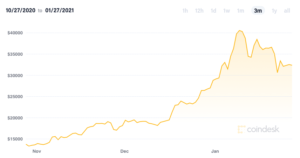Bitcoin correction tests investor resolve, but crypto markets remain active
Coinhead
Coinhead
Investors in cryptocurrency markets have endured a few tough weeks as the price of leading digital token Bitcoin plunged by around 20 per cent in Australian and US currencies.
From a high point of $52,350 ($US40,520) on January 9 to a price of $41,750 ($US32,325) on Wednesday, Bitcoin’s price drop has triggered shockwaves through the cryptocurrency community.
“With the crypto asset dipping steadily last week, some of its investors will no doubt be wondering: ‘Is this it?'”, said eToro market analyst Simon Peters, who went on to state “No”.
Despite the volatility, demand from large institutional investors in the cryptocurrency remains at impressive levels, he said.
In the wake of the price plunge for Bitcoin, large investors have backed up their trucks and loaded up on more of the cryptocurrency, Peters said.
For example, US asset manager Grayscale purchased ~$US600m of Bitcoin in one day this week, according to reports.

“The continued fear of a weakening dollar continues to benefit the price of Bitcoin, with investors looking to scarce assets to use as a hedge against rising inflation,” said Peters.
The supply of Bitcoins in circulation is limited to 21 million, and to date around 18 million have been issued, leaving around 3 million to enter the market.
Chicago-based Rothschild Investment Corporation has this week increased its investment in Grayscale which is owned by Digital Currency Group (also the parent company of Coindesk).
They join the Michael Saylor-led business software firm MicroStrategy (Nasdaq:MSTR) that has accumulated 70,000 Bitcoins as part of the company’s Treasury Reserve Policy.
The tech company was back buying $US10m worth of Bitcoin last week, adding to positions that cost $US600m, and MicroStrategy is now worth $US5.2bn.
US investment fund BlackRock, the world’s largest asset manager, announced last week that two of its funds will trade in Bitcoin derivatives in the future.
“The demand is not slowing and I believe that many investors will view any significant dip not as a bubble, but as an opportunity arisen,” said Peters.
“Investors of all sizes will be looking at a price in the region of $US28,000 as an excellent chance to top up their positions,” he stated.
The eToro market analyst said he believed that Bitcoin’s recent decline isn’t as severe as the end of the 2017 bull market.
“The price movement is a perfectly natural correction, one which happens in all assets once the market has perceived them to be a little overbought,” he said.
“Despite any very short-term movements, the fundamental backdrop for Bitcoin remains positive and my minimum price target of $US70,000 for the end of 2021 remains in place,” said Peters.
Meanwhile, the European Central Bank has teamed up with the European Commission to investigate the policy, legal and technical aspects of a central bank digital currency.
Peters said he interpreted the action as a positive move by European authorities toward a new digital currency.
This initiative would ultimately benefit the wider crypto space by introducing more consumers to digital money.
“The world is being digitised, and the financial system needs to keep up,” he said.
Second-placed cryptocurrency in terms of market popularity, Ethereum, touched a record price of $1,825 ($US1,410) on January 20.
But the digital token’s price had slipped to $1,640 ($US1,350) on Wednesday, as competition increased in the cryptocurrency space with new alt coins Polkadot and Cardano.
“Ethereum bucked the trend set by Bitcoin. Instead of sinking, the smart contract platform’s token hit an all-time high on a number of exchanges,” said eToro analyst, David Derhy.
“Given the dip from Bitcoin and the steadiness of Ethereum, we could see investors move capital into the latter as they look for the next crypto asset that is going to perform in the current bull run,” he said.
A futures derivatives contract for Ethereum is scheduled to start trading on the Chicago Mercantile Exchange (CME) in February that will allow institutional investors to trade.
According to the findings of a report commissioned by eToro on the main barriers to institutional investors trading cryptocurrencies, there are four main issues.
They are regulatory uncertainty, perceived immature market infrastructure, reputational risk and security issues, and inefficient market capitalisation.
“The perceived insufficient market cap size was the most cited hindrance from the institutional market participants that were interviewed [for the report],” said Peters.
Bitcoin has a current market value of ~$745bn while Ethereum is currently trading with a market cap of ~$185bn, according to Coindesk data.
There are two possible routes that institutional investors might follow into the cryptocurrency market as barriers to entry begin to fade and risks are addressed.
“Firstly, institutional investors may look to invest in companies that are part of the crypto ecosystem: firms that have gone public and generate a significant portion of their revenue from crypto asset-related activities, such as being an exchange, or offering third party custody or related services,” said Peters.
“The second option, and this is most likely in my eyes, would be to invest in an index of crypto assets,” he said.
This may be akin to a stock market index like the Nasdaq or S&P 500 for different US equities, and S&P Dow Jones is gearing up to launch a crypto index later this year.
An advantage to this, is that institutional investors would not need to carry out due diligence on each cryptocurrency in the proposed index.
“Just as 2020 was the year of the institutional investment in Bitcoin, so 2021 could be the year of the crypto asset index,” Peters said.